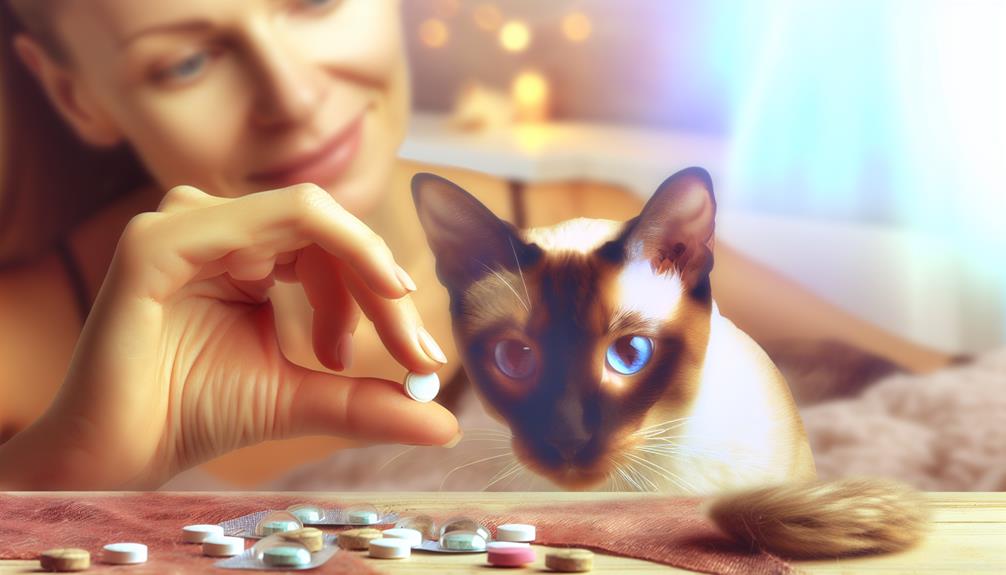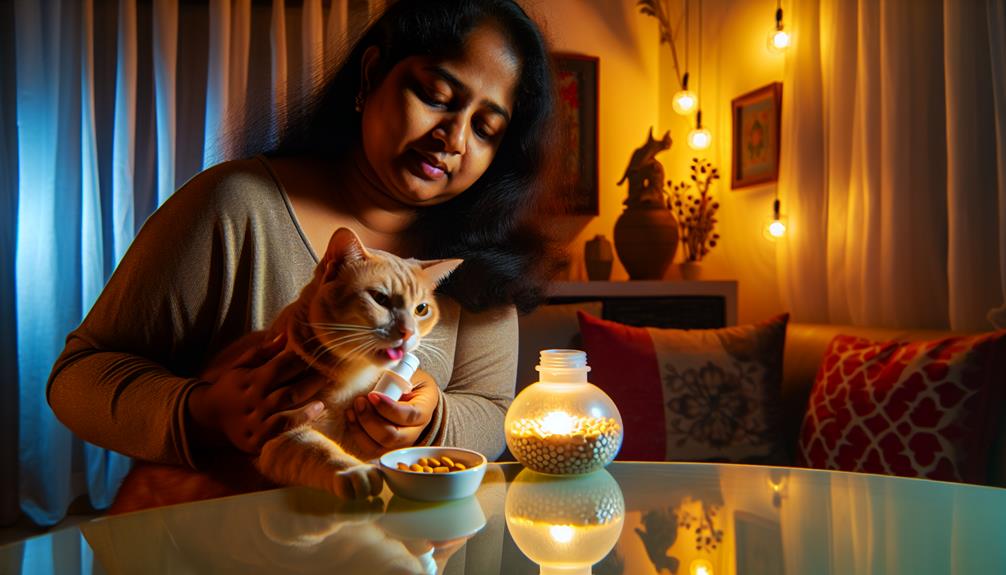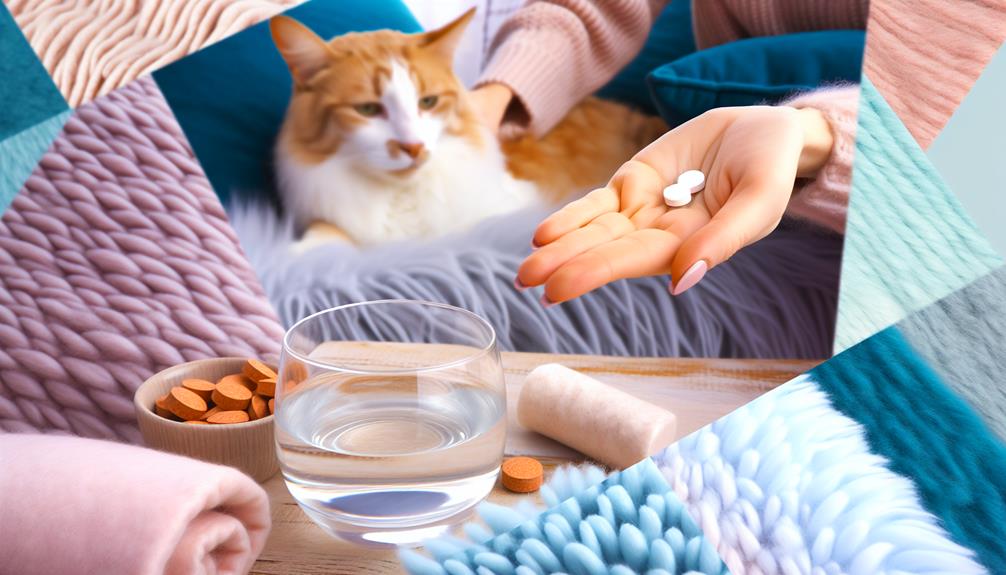Giving a cat a pill can seem like an impossible mission, but there are strategies that make it manageable. You'll need to start by preparing the pill and choosing a calm moment when your cat is relaxed. Sometimes, using a pill pocket or a bit of wet food can do the trick, but what if your cat isn't easily fooled? There are other methods that might suit your situation better. Ready to discover what to do next?
Prepare the Pill
When preparing the pill, it's essential to first verify the medication type and dosage prescribed by your veterinarian, guaranteeing no room for error. Accurate administration is vital to avoid adverse effects and guarantee therapeutic efficacy. Consult the prescription to confirm whether the medication is a tablet, capsule, or chewable; each pill type may require a different handling approach.
Dosage instructions should be meticulously followed. Some tablets are scored, allowing for precise splitting if a partial dose is required. However, not all medications are designed to be divided, and improper splitting can lead to inaccurate dosing. Use a pill cutter to achieve a clean, precise cut if your veterinarian has indicated that splitting is permissible. Capsules, on the other hand, are typically not meant to be divided, as the medication is often distributed unevenly within the encapsulated form.
Inspect the pill to guarantee it's intact and free from damage. A compromised pill could lead to reduced effectiveness or unexpected side effects. If the pill appears damaged, consult your veterinarian for a replacement. For certain medications, compounding into a flavored liquid or transdermal gel might be recommended, especially for cats that are particularly finicky or difficult to medicate.
Choose the Right Time
When administering a pill to your cat, it's vital to assess their mood to guarantee they are calm and receptive. A quiet environment is essential, as it minimizes external stimuli that could agitate your cat. Reducing distractions will facilitate a smoother and less stressful process for both you and your pet.
Assess Cat's Mood
Understanding your cat's temperament is vital before attempting to administer medication. Feline behavior can vary widely, and recognizing signs of anxiety or agitation will help you choose the right moment to give a pill. Cats are creatures of habit, and sudden changes can exacerbate feline anxiety, making the task more challenging. Evaluating your cat's mood involves observing its body language and typical daily patterns.
| Observable Behavior | Indicator of Mood | Suggested Action |
|---|---|---|
| Purring, relaxed posture | Calm and content | Proceed with medication |
| Ears back, tail flicking | Agitated or anxious | Wait for a calmer moment |
| Hiding, avoiding contact | High stress or fear | Postpone and reassess later |
| Slow blinking, kneading | Comfortable and trusting | Ideal time for intervention |
Monitor your cat's behavior closely. If your cat is purring and appears relaxed, it's likely a good time to proceed. Conversely, if your cat displays signs of agitation, such as ears pinned back or a flicking tail, it's best to wait until it calms down. Recognizing these subtle cues can greatly reduce the likelihood of stress-induced reactions and make the pill administration process smoother. Proper timing, based on accurate mood evaluation, is essential for a successful and minimally traumatic experience for both you and your feline companion.
Quiet Environment Matters
Guaranteeing a quiet environment is essential when administering a pill to your cat, as external stimuli can greatly heighten stress levels. Cat behavior is highly sensitive to environmental factors, and any sudden noise or movement can make the process exponentially more challenging. To mitigate this, choose a time when the household is calm. Early mornings or late evenings often present fewer disturbances, making them ideal for this task.
Your cat's daily routine should also be considered. Observe when they are most relaxed, which is typically after a meal or a period of play. This can make them more amenable to handling. Additionally, selecting a secluded area away from high-traffic zones in your home minimizes the risk of unexpected interruptions.
When setting up, guarantee that all necessary items—pill, treats, and any applicators—are within reach. This preparation avoids the need for last-minute scrambling, which can elevate both your stress and your cat's. Remember, a quiet and controlled environment considerably influences cat behavior and can make the difference between a successful administration and a stressful struggle. Proper consideration of environmental factors will create a smoother and less stressful experience for both you and your feline companion.
Minimize Distractions
Choosing the right time to give your cat a pill is vital for minimizing distractions and guaranteeing a smoother administration process. Understanding cat behavior is important. Opt for moments when your cat is naturally calm, such as after a meal or during a resting period. Avoid administering the pill during high-energy times, such as play sessions or when guests are around, as these situations can exacerbate anxiety and resistance.
Distraction techniques can be highly effective in managing your cat's attention. Before attempting to give the pill, make sure that the environment is free from potential disturbances. Turn off loud appliances, and if possible, have other pets in a different room. Utilize positive reinforcement by rewarding your cat with treats or affection before and after the process. This not only diverts their attention but also creates a positive association with the medication routine.
Timing is paramount. Early mornings or late evenings, when the household is typically quieter, are often ideal. By strategically choosing a low-distraction time, you can greatly reduce stress for both you and your cat, making the task of administering medication much more manageable.
Use Pill Pockets

Pill pockets can greatly ease the administration of oral medication to your cat. It's essential to choose a flavor your cat finds palatable to guarantee compliance. Proper technique involves molding the pocket around the pill completely to prevent detection and rejection.
Choose the Right Flavor
Finding the right flavor for administering medication to your feline companion can greatly simplify the process. Cats are notoriously selective eaters, and their preference for certain flavors can greatly impact your success rate. Pill pockets, which are soft, malleable snacks designed to encase pills, come in various flavors tailored to feline tastes. Popular options include chicken, salmon, and tuna. Selecting a flavor that your cat already enjoys can increase the likelihood that they will consume the medication without resistance.
Pillow placement within the pill pocket is essential for proper administration. Making sure the pill is fully encapsulated prevents your cat from detecting and rejecting the medication. Gently mold the treat around the pill, effectively concealing it. This technique can mitigate any aversions your cat might have to the pill's taste or texture.
If your cat is particularly finicky, consider treat alternatives. Some cats may respond better to different types of flavored treats or even a small portion of their favorite wet food. Always consult with your veterinarian before using any alternative methods to make certain they are safe for your cat's specific medication and health condition. By prioritizing the right flavor and method, you can streamline the pill-giving process.
Ensure Proper Technique
When administering medication to your cat, guaranteeing proper technique is vital for success. One effective method to simplify this process is the use of pill pockets. These specially designed treats encapsulate the medication, making it more palatable for your feline. This not only eases the administration but also reduces stress for both you and your cat.
Understanding cat behavior is essential in implementing successful pilling techniques. Cats are naturally suspicious of new objects and tastes. Consequently, introducing pill pockets gradually can mitigate resistance. Start by offering your cat an empty pill pocket as a treat, allowing them to get accustomed to its flavor and texture. Once they accept it readily, you can proceed by concealing the medication within the pocket.
Confirm that the pill is fully enclosed within the pocket to prevent detection. Holding the pill pocket with the medication inside, present it to your cat as you would a regular treat. Observe your cat's behavior closely to verify they ingest the entire pocket, including the pill. If your cat tends to chew treats, gently encourage them to swallow by offering a small amount of water afterward.
Try Manual Administration
Administering a pill to a cat manually can be a challenging but often necessary task. Understanding cat behavior is fundamental to guarantee both the medication's efficacy and the cat's safety. Start by calmly approaching your cat, as sudden movements or loud noises can induce stress, making the process more difficult.
To begin, hold your cat securely but gently. Wrapping your cat in a towel can help minimize movement and provide a sense of security. This method, sometimes referred to as a "cat burrito," can markedly reduce the risk of scratches and bites. Make sure the cat's head remains exposed for the administration of the medication.
Next, using your non-dominant hand, gently grasp the cat's head from above, positioning your thumb on one side of the jaw and your fingers on the other. Tilt the head back slightly, which will encourage the cat to open its mouth. With your dominant hand, hold the pill between your thumb and index finger. Carefully place the pill as far back on the tongue as possible, ideally near the base.
It's important to quickly close the cat's mouth and hold it shut while gently stroking the throat to stimulate swallowing. Be patient; some cats may take a few moments to swallow the pill. Monitoring for successful ingestion is essential for medication safety. If the pill is spit out, you may need to repeat the process or consult your veterinarian for alternative methods.
Use a Pill Dispenser

Utilizing a pill dispenser can be an effective and less stressful method for medicating your cat. This tool is particularly beneficial for administering various pill types, including tablets and capsules. A pill dispenser, sometimes referred to as a pill gun or piller, allows for precise and controlled delivery of medication directly into your cat's throat, reducing the risk of accidental biting or injury.
The primary dispenser benefits include minimizing stress for both you and your feline companion. Unlike manual administration, where cats may become anxious or resist by scratching or biting, a pill dispenser guarantees a more streamlined process. It also reduces the likelihood of the pill being spat out, ensuring that your cat receives the full dosage required for effective treatment.
To use a pill dispenser, first, load the medication into the device according to the manufacturer's instructions. Pill dispensers often have a plunger mechanism that securely holds the pill until it is released. Gently restrain your cat, opening its mouth slightly by pressing at the hinge of the jaw. Position the pill dispenser toward the back of the throat, then press the plunger to release the pill. This method guarantees that the medication is deposited where it is less likely to be rejected.
Different pill types may require specific dispensers, so consult your veterinarian to select one that best suits your cat's needs. Using a pill dispenser can notably enhance compliance with prescribed treatments, promoting better health outcomes for your cat. This method underscores the importance of reducing stress and improving the efficiency of the medication process.
Reward and Comfort
Rewarding and comforting your cat post-medication is vital for maintaining a positive association with the process. After successfully administering the pill, immediately offer treat rewards. These treats should be highly palatable and specifically chosen for their appeal to your cat. This positive reinforcement helps in conditioning your cat to associate the medication process with something enjoyable, thereby reducing resistance in future administrations.
Utilizing calming techniques is equally important. Gently pet your cat, focusing on areas they enjoy, such as under the chin or behind the ears. Speak in a soft, soothing voice to help alleviate any residual stress. If your cat responds positively to brushing, incorporate that into your post-medication routine. These calming techniques foster a sense of safety and comfort, mitigating any anxiety experienced during the medication process.
It's also beneficial to create a tranquil environment post-medication. Minimize loud noises and disruptions in the immediate vicinity. A quiet, cozy spot can serve as a retreat where your cat feels secure. Providing a familiar blanket or a favorite toy can further enhance their comfort level.
Monitor your cat for any signs of distress or discomfort post-administration. If you notice prolonged stress or adverse reactions, consult with your veterinarian. They may provide additional calming techniques or alternative methods to ease the medication process.
Incorporating treat rewards and calming techniques into your post-medication routine not only improves your cat's immediate experience but also establishes a long-term positive association with the process. This approach is vital for the well-being of your feline companion and guarantees a smoother, less stressful medication regimen.
Conclusion
Giving a cat a pill can be a challenging task, but with the right techniques, it becomes manageable. By juxtaposing patience with precision, you guarantee the cat's well-being. Whether using pill pockets for ease or manual administration for necessity, each method requires care and confidence. Follow up with praise or a treat to reinforce positive associations. Remember, a stress-free experience for your cat translates to effective medication adherence. Approach it with expertise, and success is within reach.
